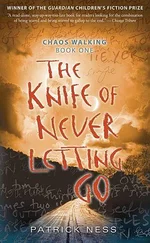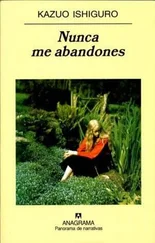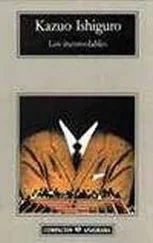“How did it get there?” I asked.
“How do I know? Maybe they wanted to dump it, whoever owned it. Or maybe sometime, when everything was flooded, it just drifted in and got itself beached. Who knows? It’s supposed to be this old fishing boat. With a little cabin for a couple of fishermen to squeeze into when it’s stormy.”
The next few times I came to see her, she always managed to bring up the boat again. Then one afternoon, when she began telling me how one of the other donors at the centre had been taken by her carer to see it, I said to her:
“Look, it’s not particularly near, you know. It would take an hour, maybe an hour and a half to drive.”
“I wasn’t suggesting anything. I know you’ve got other donors to worry about.”
“But you’d like to see it. You’d like to see this boat, wouldn’t you, Ruth?”
“I suppose so. I suppose I would. You spend day after day in this place. Yeah, it’d be good to see something like that.”
“And do you suppose”—I said this gently, without a hint of sarcasm—“if we’re driving all that way, we should think about calling in on Tommy? Seeing his centre’s just down the road from where this boat’s meant to be?”
Ruth’s face didn’t show anything at first. “I suppose we could think about it,” she said. Then she laughed and added: “Honest, Kathy, that wasn’t the only reason I’ve been going on about the boat. I do want to see it, for its own sake. All this time in and out of hospital. Then cooped up here. Things like that matter more than they once did. But all right, I did know. I knew Tommy was at the Kingsfield centre.”
“Are you sure you want to see him?”
“Yes,” she said, no hesitation, looking straight at me. “Yes, I do.” Then she said quietly: “I haven’t seen that boy for a long time. Not since the Cottages.”
Then, at last, we talked about Tommy. We didn’t go into things in a big way and I didn’t learn much I didn’t know already. But I think we both felt better we’d finally brought him up. Ruth told me how, by the time she left the Cottages the autumn after me, she and Tommy had more or less drifted apart.
“Since we were going different places to do our training anyway,” she said, “it didn’t seem worth it, to split up properly. So we just stayed together until I left.”
And at that stage, we didn’t say much more about it than that.
As for the trip out to see the boat, I neither agreed nor disagreed to it, that first time we discussed it. But over the next couple of weeks, Ruth kept bringing it up, and our plans somehow grew firmer, until in the end, I sent a message to Tommy’s carer through a contact, saying that unless we heard from Tommy telling us not to, we’d show up at the Kingsfield on a particular afternoon the following week.
I’d hardly ever been to the Kingsfield in those days, so Ruth and I had to consult the map a number of times on the way and we still arrived several minutes late. It’s not very well-appointed as recovery centres go, and if it wasn’t for the associations it now has for me, it’s not somewhere I’d look forward to visiting. It’s out of the way and awkward to get to, and yet when you’re there, there’s no real sense of peace and quiet. You can always hear traffic on the big roads beyond the fencing, and there’s a general feeling they never properly finished converting the place. A lot of the donors’ rooms you can’t get to with a wheelchair, or else they’re too stuffy or too draughty. There aren’t nearly enough bathrooms and the ones there are are hard to keep clean, get freezing in winter and are generally too far from the donors’ rooms. The Kingsfield, in other words, falls way short of a place like Ruth’s centre in Dover, with its gleaming tiles and double-glazed windows that seal at the twist of a handle.
Later on, after the Kingsfield became the familiar and precious place it did, I was in one of the admin buildings and came across a framed black-and-white photo of the place the way it was before it was converted, when it was still a holiday camp for ordinary families. The picture was probably taken in the late fifties or early sixties, and shows a big rectangular swimming pool with all these happy people—children, parents—splashing about having a great time. It’s concrete all around the pool, but people have set up deck chairs and sun loungers, and they’ve got large parasols to keep them in the shade. When I first saw this, it took me a while to realise I was looking at what the donors now call “the Square”—the place where you drive in when you first arrive at the centre. Of course, the pool’s filled in now, but the outline’s still there, and they’ve left standing at one end—an example of this unfinished atmosphere—the metal frame for the high diving board. It was only when I saw the photo it occurred to me what the frame was and why it was there, and today, each time I see it, I can’t help picturing a swimmer taking a dive off the top only to crash into the cement.
I might not have easily recognised the Square in the photo, except for the white bunker-like two-storey buildings in the background, on all three visible sides of the pool area. That must have been where the families had their holiday apartments, and though I’d guess the interiors have changed a lot, the outsides look much the same. In some ways, I suppose, the Square today isn’t so different to what the pool was back then. It’s the social hub of the place, where donors come out of their rooms for a bit of air and a chat. There are a few wooden picnic benches around the Square, but—especially when the sun’s too hot, or it’s raining—the donors prefer to gather under the overhanging flat roof of the recreation hall at the far end behind the old diving board frame.
That afternoon Ruth and I went to the Kingsfield, it was overcast and a bit chilly, and as we drove into the Square it was deserted except for a group of six or seven shadowy figures underneath that roof. As I brought the car to a stop somewhere over the old pool—which of course I didn’t know about then—one figure detached itself from the group and came towards us, and I saw it was Tommy. He had on a faded green track suit top and looked about a stone heavier than when I’d last seen him.
Beside me Ruth, for a second, seemed to panic. “What do we do?” she went. “Do we get out? No, no, let’s not get out. Don’t move, don’t move.”
I don’t know what I’d been intending to do, but when Ruth said this, for some reason, without really thinking about it, I just stepped out of the car. Ruth stayed where she was, and that was why, when Tommy came up to us, his gaze fell on me and why it was me he hugged first. I could smell a faint odour of something medical on him which I couldn’t identify. Then, though we hadn’t yet said anything to each other, we both sensed Ruth watching us from the car and pulled away.
There was a lot of sky reflected in the windscreen, so I couldn’t make her out very well. But I got the impression Ruth had on a serious, almost frozen look, like Tommy and I were people in a play she was watching. There was something odd about the look and it made me uneasy. Then Tommy was walking past me to the car. He opened a rear door, got into the back seat, and then it was my turn to watch them, inside the car, exchanging words, then polite little kisses on the cheeks.
Across the Square, the donors under the roof were also watching, and though I felt nothing hostile about them, I suddenly wanted to get out of there quickly. But I made myself take my time getting back into the car, so that Tommy and Ruth could have a little longer to themselves.

We began by driving through narrow, twisting lanes. Then we came out into open, featureless countryside and travelled on along a near-empty road. What I remember about that part of our trip to the boat was that for the first time in ages the sun started to shine weakly through the greyness; and whenever I glanced at Ruth beside me, she had on a quiet little smile. As for what we talked about, well, my memory is that we behaved much as if we’d been seeing each other regularly, and there was no need to talk about anything other than what we had immediately in front of us. I asked Tommy if he’d been to see the boat already, and he said no, he hadn’t, but a lot of the other donors at the centre had. He’d had a few opportunities, but hadn’t taken them.
Читать дальше













